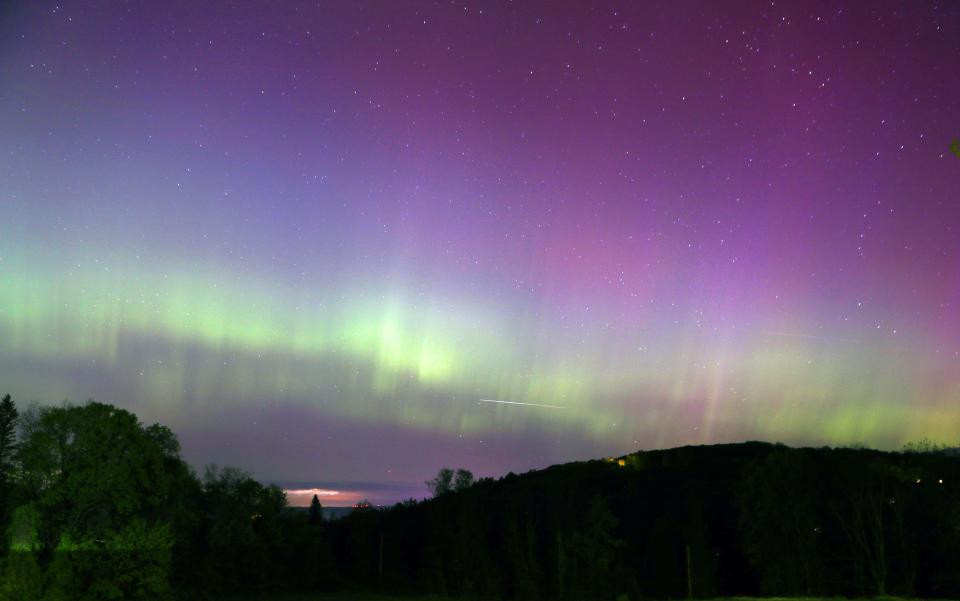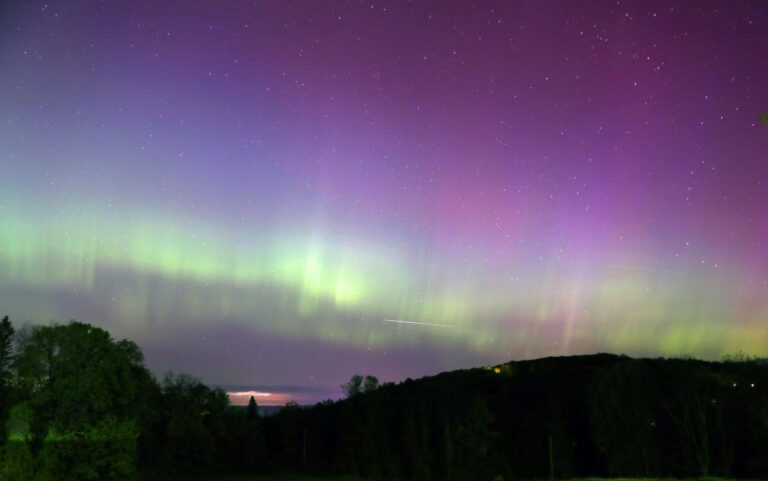Another solar storm is forecast for Earth, meaning residents of some U.S. states could have another chance to view the Northern Lights Friday evening.
THE Space Weather Prediction Center predicted that a possible geomagnetic storm would arrive on Friday, May 31 and last into the early hours of Saturday morning. According to the organization, a handful of northern states could end up with conditions suitable for viewing.
The phenomena would be the result of the same cluster of sunspots responsible for the May 10 aurora display across the countryfor they turned back in sight of the Earth.
The possibility of the lights reappearing is highly dependent on conditions and location. Here’s what you need to know about your chances of catching a Friday night light show.


Space research: New research could help predict the next solar flare
Northern Lights Forecast
The forecast center predicts a geomagnetic storm arriving on the evening of May 31 and throughout the morning of June 1. The storm is expected to reach intensity level of 2 out of 5a much lower rating than the May 10 storm, rated G5 and visible from all 50 states.
The moderate storm is the result of a coronal mass ejection, or “huge bubbles of coronal plasma strung by intense magnetic field lines that are ejected from the sun for several hours,” according to NASA. The ejection was the result of a solar flare on May 29.
However, conditions remain uncertain.
“Our confidence in the G2 event is low, mainly because we expect most of the solar material from the coronal mass ejection to pass behind Earth’s orbit,” said lead forecaster Shawn Dahl. from the forecast center. “However, our analyzes indicated that Earth could receive indirect or near influence and, based on this possibility, our forecasters saw the potential for G2 levels if this occurred.”
As the days get longer, it’s harder to see the auroras, he added, because the dark sky windows are shorter. Additionally, there must be a favorable connection between the coronal mass ejection and the Earth’s magnetic fields during the observing hours.
He recommended that those wishing to see the Northern Lights should keep an eye out the prediction center website for updates and conditions.
Which states will have the chance to see the Northern Lights?
“Aurora may become visible in some northern and upper Midwest states, from New York to Idaho,” the Space Weather Prediction Center said. posted on.
Some states most likely to get a glimpse include:
-
New Hampshire
-
Vermont
-
Maine
-
new York
-
Michigan
-
Maine
-
New Hampshire
-
Massachusetts
-
Rhode Island
-
Wisconsin
-
Minnesota
-
North Dakota
-
South Dakota
-
Montana
-
Wyoming
-
Idaho
When is the best time to see the Northern Lights?
Generally speaking, viewing the Northern Lights is best during the darkest hours of the night and early morning.
Friday’s lights should be observable between 11 p.m. Friday and 1 a.m. Saturday, although they can be seen until about 3 a.m., according to the National Oceanic and Atmospheric Administration.
“If G1-G2 conditions do indeed materialize…tonight would most likely be the time to be on the lookout – much less likely Saturday night,” Dahl said.
What are the Northern Lights?
The Northern Lights are a bright glow observed around the magnetic poles of the Northern and Southern Hemispheres, according to the University of Alaska Fairbanks Geophysical Institute. Known for creating ribbons of colored light in the night sky, the Northern Lights are polar lights, or polar auroras, that appear in the Northern Hemisphere.
The southern hemisphere has its own polar lights known as the aurora australis, or aurora australis, which create their own dazzling spectacle.
What causes the Northern Lights?
Simply put, auroras are the result of the sun’s interaction with the Earth’s atmosphere. A collision between electrically charged particles from the sun and gases in Earth’s atmosphere produces a series of tiny flashes that appear as moving lights in the sky. Charged particles are attracted to the North and South Poles due to the Earth’s magnetic field.
Although this magnetic field generally protects Earth from solar winds, winds can sometimes become strong enough to bypass the field, allowing particles and gases in the magnetosphere to interact and generate colorful displays, according to the Geophysical Institute and THE Canadian Space Agency.
This article was originally published on USA TODAY: Will you see the Northern Lights tonight? Here’s what you need to know


